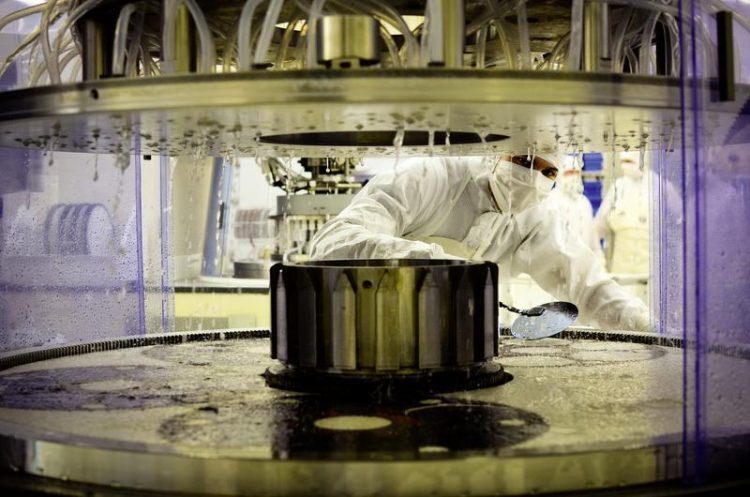Pulling crystals for semiconductor technology

The GaAs crystals are sawn into wafers before being subsequently polished in a chemical-physical process. © Freiberger Compound Materials GmbH
Crystalline semiconductor components form the core of many modern communication technologies such as computers and mobile phones. They are produced during a multi-day pulling process that uses considerable energy.
The BINE-Projektinfo brochure “Efficient production of monocrystalline semiconductors” (01/2015) presents a new method for producing gallium arsenide crystals. Instead of growing individual crystals as was previously the case, nine crystals are now grown in parallel from the melt. This reduces the specific energy consumption for the production by two thirds.
In addition to silicon, which still dominates semiconductor technology, gallium arsenide has also established itself as a substrate material for high-purity single crystals. With these crystals the atoms are arranged in an almost perfect lattice, whereby only every millionth atom is a foreign element.
The crystals are pulled from hot melt, which has a temperature of up to 1,300 °C, during a process that takes several days. With the new method, the developers have succeeded in increasing both the solidification rate and yield.
The challenge with parallel growth is to supply the heat and arrange the nine crystals in such a manner that the structure and purity of the final product are not impaired.
The new method has been developed by the Freiberger Compound Materials (FCM) company. Dr Berndt Weinert, R&D Manager at FCM: “The method has proved itself in practice and the production has almost completely moved over to using it. An estimated 4,000 MWh were saved in 2014.” The company has since then converted its entire production to the new method.
The BINE-Projektinfo brochure “Efficient production of monocrystalline semiconductors” (01/2015) follow this link:
http://www.bine.info/en/press/press-releases/press/pressemitteilung/kristalle-fu…
Press contact
Uwe Milles
presse(at)bine.info
About BINE Information Service
Energy research for practical applications
The BINE Information Service reports on energy research topics, such as new materials, systems and components, as well as innovative concepts and methods. The knowledge gained is incorporated into the implementation of new technologies in practice, because first-rate information provides a basis for pioneering decisions, whether in the planning of energy-optimised buildings, increasing the efficiency of industrial processes, or integrating renewable energy sources into existing systems.
About FIZ Karlsruhe
FIZ Karlsruhe – Leibniz Institute for Information Infrastructure is a not-for-profit organization with the public mission to make sci-tech information from all over the world publicly available and to provide related services in order to support the national and international transfer of knowledge and the promotion of innovation.
Our business areas:
• STN International – the world’s leading online service for research and patent information in science and technology
• KnowEsis – innovative eScience solutions to support the process of research in all its stages, and throughout all scientific disciplines
• Databases and Information Services – Databases and science portals in mathematics, computer science, crystallography, chemistry, and energy technology
FIZ Karlsruhe is a member of the Leibniz Association (WGL) which consists of 87 German research and infrastructure institutions.
http://www.bine.info/en – BINE-Informationsdienst
Media Contact
All latest news from the category: Power and Electrical Engineering
This topic covers issues related to energy generation, conversion, transportation and consumption and how the industry is addressing the challenge of energy efficiency in general.
innovations-report provides in-depth and informative reports and articles on subjects ranging from wind energy, fuel cell technology, solar energy, geothermal energy, petroleum, gas, nuclear engineering, alternative energy and energy efficiency to fusion, hydrogen and superconductor technologies.
Newest articles

A ‘language’ for ML models to predict nanopore properties
A large number of 2D materials like graphene can have nanopores – small holes formed by missing atoms through which foreign substances can pass. The properties of these nanopores dictate many…

Clinically validated, wearable ultrasound patch
… for continuous blood pressure monitoring. A team of researchers at the University of California San Diego has developed a new and improved wearable ultrasound patch for continuous and noninvasive…

A new puzzle piece for string theory research
Dr. Ksenia Fedosova from the Cluster of Excellence Mathematics Münster, along with an international research team, has proven a conjecture in string theory that physicists had proposed regarding certain equations….



